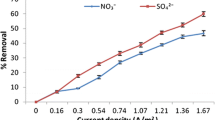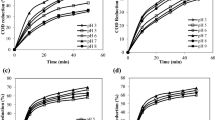Abstract
Sugar industry effluent (SIE) is characterized as high organic load. The aim of present work is to treat SIE in sequential batch reactor (SBR). Effect of hydraulic retention time (HRT) on COD reduction was studied at instantaneous fill condition. Maximum 67.2% COD removal was achieved at HRT of 2.33 days (d) in 10 h of treatment. At optimum HRT of 2.33 days, the fill time (tF) of the effluent was varied to treat it, in which tF of 1.5 h was evaluated to optimum for maximum of 91.66% COD removal of initial COD of 4800 mg/dm3 achieved in 10 h of treatment. The effluent treated in SBR was further followed by electrocoagulation (EC) using mild steel (MS) electrode. The initial COD of 640 mg/dm3 was reduced to 77 mg/dm3 at operating condition of current density 69.44 A/m2 (2A) and treatment time (tR) ~ 90 min. The kinetics of degradation of SIE in SBR was also evaluated.





Similar content being viewed by others

References
Atashi, H., H. Ajamein, and S. Ghasemian. 2010. Effect of operational and design parameters on removal efficiency of a pilot-scale UASB reactor in a sugar factory. World Applied Sciences Journal 11: 451–456.
Benitez, A., A. Ferrari, S. Gutierrez, R. Canetti, A. Cabezas, D. Travers, J. Menes, and C. Etchebehere. 2006. Sequencing batch reactor as a post-treatment of anaerobically treated dairy effluent. Water Science and Technology 54(2): 199–206.
Bogliolol, M., A. Bottinol, G. Caparmellil, G. De Petrol, A. Servidal, G. Pezzi, and G. Vallini. 1996. Clean water recycle in sugar extraction process: Performance analysis of reverse osmosis in the treatment of sugar beet press water. Desalination 108: 261–271.
Can, O.T., M. Kobya, E. Demirbas, and M. Bayramoglu. 2006. Treatment of the textile wastewater by combined electrocoagulation. Chemosphere 62: 181–187.
Central Pollution Control Board (CPCB). 2006. Pollution control acts, rules and notification there. Delhi: Central Pollution Control Board.
Chauhan, M.K., S. Chaudhary, and S. Kumar. 2011. Life cycle assessment of sugar industry: A review. Renewable and Sustainable Energy Reviews 15: 3445–3453.
Gaval, G., and J.J. Pernell. 2003. Impact of the repetition of oxygen deficiencies on the filamentous bacteria proliferation in activated sludge. Water Research 2(37): 1991–2000.
Gondudey, S., and P.K. Chaudhari. 2019. Treatment of sugar industry effluent through SBR followed by electrocoagulation. Sugar Tech. https://doi.org/10.1007/s12355-019-00753-6.
Guven, G., A. Perendeci, and A. Tanyolac. 2009. Electrochemical treatment of simulated beet sugar factory wastewater. Chemical Engineering Journal 151: 149–159.
Kargi, F., and A. Uygur. 2003. Nutrient removal performance of a five-step sequencing batch reactor as a function of wastewater composition. Process Biochemistry 38: 1039–1045.
Katal, R., and H. Pahlavanzadeh. 2011. Influence of different combinations of aluminum and iron electrode on electrocoagulation efficiency: Application to the treatment of paper mill wastewater. Desalination 265: 199–205.
Khan, M., U. Kalsoom, T. Mahmood, M. Riaz, and A.R. Khan. 2003. Characterization and treatment of industrial effluent from sugar industry. Journal of the Chemical Society 25: 242–247.
Kushwaha, J.P. 2013. A review on sugar industry wastewater: Sources, treatment technologies, and reuse. Desalination and Water Treatment 53: 309–318.
Kushwaha, J.P., V.C. Srivastava, and I.D. Mall. 2013. Sequential batch reactor for dairy wastewater treatment: Parametric optimization; kinetics and waste sludge disposal. Journal of Environmental Chemical Engineering 1: 1036–1043.
Macarie, H., and J.L. Mer. 2006. Overview of the biological processes available for the treatment of sugarcane mill wastewater. International Sugar Journal 108(1292): 431–439.
Mahesh, S., B. Prasad, I.D. Mall, and I.M. Mishra. 2006. Electrochemical degradation of pulp and paper mill wastewater: Part 2 Characterization and analysis of sludge. Industrial and Engineering Chemistry Research 45: 5766–5774.
Marrot, B., A. Barrios-Martinez, P. Moulin, and N. Roche. 2006. Biodegradation of high phenol concentration by activated sludge in an immersed membrane bioreactor. Biochemical Engineering Journal 30: 174–183.
Mohan, S.V., N.C. Rao, K.K. Prasad, B.T.V. Madhavi, and P.N. Sharma. 2005. Treatment of complex chemical wastewater in a sequencing batch reactor (SBR) with an aerobic suspended growth configuration. Process Biochemistry 40(5): 1501–1508.
Monod, J. 1949. The growth of bacterial cultures. Annual Review of Microbiology 3: 371–394.
Montuelle, B., J. Coillard, and J.B. Lehy. 1992. A combined anaerobic-aerobic process for the Co-treatment of effluents from a piggery and a cheese factory. Journal of Agricultural Engineering Research 51: 91–100.
Okpokwasili, G.C., and C.O. Nweke. 2005. Microbial growth and substrate utilization kinetics. African Journal of Biotechnology 5:305–317.
Peavy, H.S., D.R. Rowe, and G. Tchobanoglous. 2009. Environmental engineering. New York: McGraw-Hill Higher Education.
Rice, E.W., R.B. Baired, A.D. Eaton, and L.S. Clesceri. 2012. Standard methods for the examination of water and wastewater, 22nd ed., Washington DC.
Sahu, O.P., B. Mazumdar, and P.K. Chaudhari. 2013. Treatment of wastewater by electrocoagulation. Environmental Science and Pollution Research 21: 2397–2413.
Sahu, O.P., D.G. Rao, R. Gopal, A. Tiwari, and D. Pal. 2017. Treatment of wastewater from sugarcane process industry by electrochemical and chemical process: Aluminum (metal and salt). Journal of Water Process Engineering 17: 50–62.
Sahu, O.P., and P.K. Chaudhari. 2015. Electrochemical treatment of sugar industry wastewater: COD and color removal. Journal of Electroanalytical Chemistry 739: 122–129.
Sharma, V., V.C. Srivastava, J.P. Kushwaha, and I.D. Mall. 2010. Studies on biodegradation of resorcinol in sequential batch reactor. International Biodeterioration and Biodegradation 64: 764–768.
Thakur, C., V.C. Srivastava, and I.D. Mall. 2014. Aerobic degradation of petroleum refinery wastewater in sequential batch reactor. Journal of Environmental Science and Health. Part A 49: 1436–1444.
Tsang, Y.F., F.L. Hua, H. Chua, S.N. Sin, and Y.J. Wang. 2007. Optimization of biological treatment of paper mill effluent in a sequencing batch reactor. Biochemical Engineering Journal 34: 193–199.
United State Environmental Protection Agency (EPA).1999. Wastewater technology fact sheet, sequencing batch reactor, Washington DC: Office of water.
Wilderer, P.A., R.L. Irvine, and C. Mervyn. 2001. Sequencing batch reactor technology. London: International Water Association Publishing.
Wilean, B.M., and P. Balmer. 1999. The effect of dissolved oxygen concentration on the structure, size and size distribution of activated sludge flocs. Water Research 33: 391–400.
Yetis, M., U. Gunduz, I. Eroglu, M. Yucel, and L. Turker. 2000. Photoproduction of hydrogen from sugar refinery wastewater by rhodobacter sphaeroides. International Journal of Hydrogen Energy 25: 1035–1041.
Acknowledgements
The funding was provided by Science and Engineering Research Board (SERB), New Delhi, India (File No: EEQ/2016/000068).
Author information
Authors and Affiliations
Corresponding author
Ethics declarations
Conflict of interest
The authors declare that they have no conflict of interest.
Additional information
Publisher's Note
Springer Nature remains neutral with regard to jurisdictional claims in published maps and institutional affiliations.
Rights and permissions
About this article
Cite this article
Gondudey, S., Chaudhari, P.K. Treatment of Sugar Industry Effluent Through SBR Followed by Electrocoagulation. Sugar Tech 22, 303–310 (2020). https://doi.org/10.1007/s12355-019-00777-y
Received:
Accepted:
Published:
Issue Date:
DOI: https://doi.org/10.1007/s12355-019-00777-y



